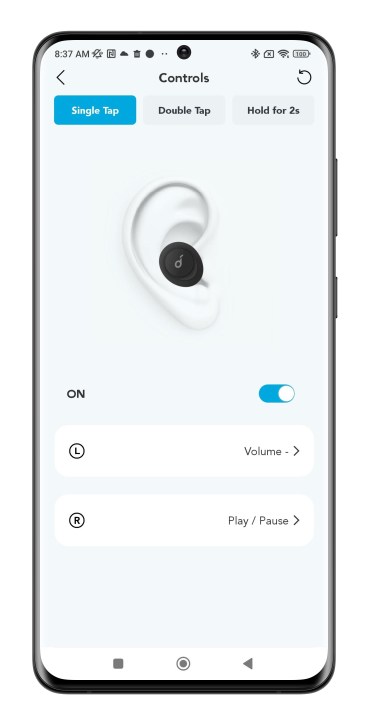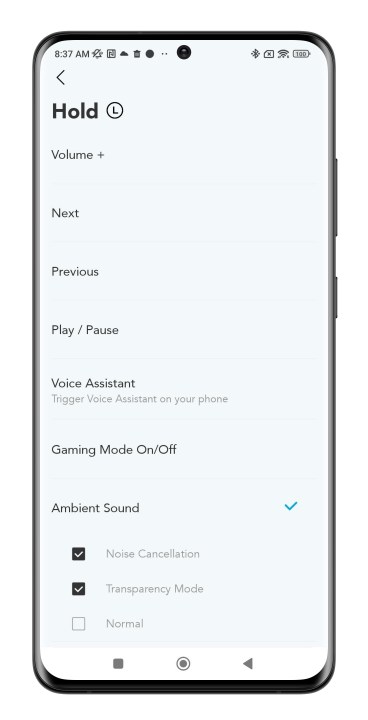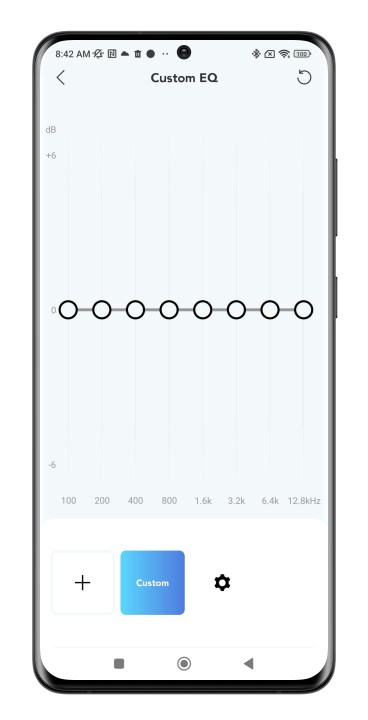“The Soundcore Space A40 wireless earbuds do almost everything, they do it well, and they do it affordably.”
- Compact and comfortable
- Good sound quality
- Very good ANC/transparency
- Good call quality
- Excellent battery life
- Wireless charging
- Bluetooth multipoint
- No wear sensors
- So-so wireless range
It wasn’t that long ago that buying a set of budget wireless earbuds — ones that cost $100 or less — meant accepting a series of compromises. Maybe you’d end up with subpar sound, limited battery life, and no ability to customize the earbuds’ functions or EQ with a mobile app. And advanced features like active noise cancellation (ANC), hi-res audio, and wireless charging? Fuhgeddaboudit.
But those days are long gone thanks in part to Anker’s Soundcore division, which has been redefining what we can expect from affordable buds for years. And if you need more convincing, try this on for size: Soundcore’s new $100 Space A40 wireless earbuds have a list of features that wouldn’t look out of place on a model costing double that price, plus a battery life that might not have an equal at any price.
Are these the best budget wireless earbuds you can buy? Let’s take a look.
What’s in the box?

Pretty standard stuff: The earbuds, their charging case, a USB-A to USB-C charging cable, and a generous set of five sizes of silicone rubber eartips, with the medium size preinstalled on the buds, and a quick-start guide. It’s all packed into a small cardboard box. Props to Soundcore for finally eliminating almost all nonrecyclable material in its packaging.
Design
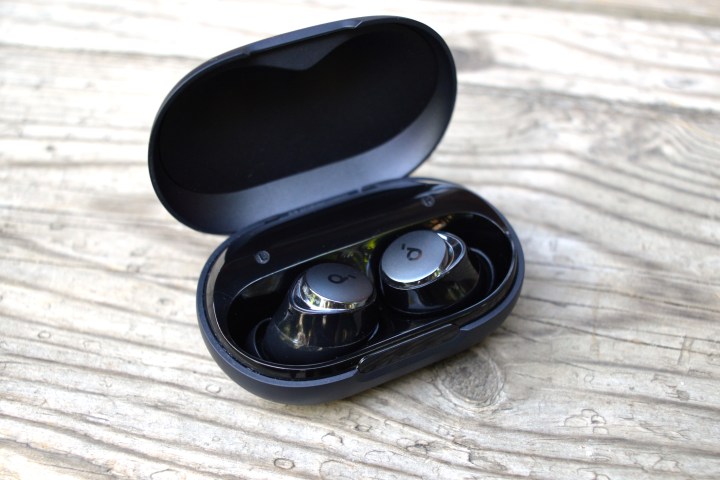
Soundcore hasn’t been afraid to experiment with different shapes, sizes, and designs for its earbuds, and this time around, it has picked a compact, stemless option. They’re smaller than both the Jabra Elite 7 Pro and the Google Pixel Buds Pro. I’d call them plain, or generic-looking, except for their satin-finish outer surface, with a discreet Soundcore “d” logo, which gives them a little touch of class.
Those surfaces are touch-sensitive, and the earbuds have an IPX4 rating, which means you should be able to get them sweaty or damp without fear as long as you wipe them clean when you’re done using them.
The Space A40 are very comfortable, even for long periods of time.
The case — which can recharge via USB-C or wirelessly using a Qi-compatible charging mat — is finished in a matte black plastic and has a smooth, rounded shape that feels good in the hand and is small enough to be pocketable. The lid flips open and closed effortlessly, and thanks to its generous opening, it’s supereasy to pluck the A40s out and put them back in again.
You get a three-LED indicator on the front, which can show you the charge level for the earbuds when they’re in the case, as well as for the case itself when the earbuds are removed. The Soundcore app also will show you the earbuds’ charge level.
Comfort, controls, and connections

I found the Space A40 very comfortable, even for long periods of time. For me, their rounded shape is very ergonomic and hits that Goldilocks zone of being big enough to make excellent contact with my concha, while not being so big that it makes my ears feel like they’re jammed with an object.
The default medium tips fit me just fine, but Soundcore can help you find your perfect size with the fit test feature inside the Soundcore app, which plays a series of tones to determine if there are any sound leaks.
Once seated, I found the earbuds very secure. They only loosened a bit when I was talking, but that’s been my experience with almost all earbuds. I’d have no problem recommending them for even very active workouts, though that will really depend on how securely they sit in your ears.
The controls are touch-sensitive, so there will always be the occasional unintentional hit. But as touch controls go, the A40 are very good. The surfaces are large and easy to tap, and the app lets you turn on (or off) a confirmation tone for taps, which I find very helpful. My only complaint is that those tones lag a bit — you tap, and then a second later, you hear the tone. I’d prefer a faster response time.
You also can fully modify what the tap gestures do. There are six in total — single tap, double tap, and tap-and-hold on each side — and you can pick what each does in the app. You can choose from play/pause, track skip forward/back, volume up/down, voice assistant access, and ANC mode switching. Call answer/end is always available when calls come in, and you can use each earbud independently for both music and calls.
They’re a fun listen and should please just about anyone shy of massive bass fanatics.
The only thing missing here is a wear sensor: The Space A40 can’t automatically pause your tunes when you remove an earbud. You can’t have it all for $100, and as omissions go, this one doesn’t bother me.
The Space A40 use Bluetooth 5.2, which should offer excellent wireless range, but I found the earbuds couldn’t go as far from my devices as I’ve been able to do with other 5.2 buds. It’s not bad when connected using SBC or AAC as the Bluetooth codec (say, on an iPhone) — you’ll get about 25 feet indoors and maybe 40-50 feet outside — but switching to the LDAC codec on Android drops that by about half.
Getting the A40 paired on iOS and Android was easy. When I first got the A40 set up on my Android handset, I immediately enabled the LDAC codec to see how it sounded. Little did I know, LDAC is incompatible with Bluetooth multipoint, so when I tried to connect to two devices and it didn’t work, I assumed a mistake had been made in the specs.
As it turns out, as long as LDAC is turned off, multipoint is indeed a feature and it works great — yet another impressive aspect to these earbuds.
Sound quality

Audiophiles won’t be wowed by the Space A40. But they sound really good given the $100 price. You get a full frequency response from these earbuds, with bass that is strong enough to let you feel the beat, but not so powerful that it overwhelms.
The ANC on these earbuds is the real deal.
With the default EQ settings, I found the mids and highs a little dull. If you experience this too, be sure to go through the HearID tuning procedure in the Soundcore app. After doing so, I noticed an immediate improvement, and much of the clarity I thought was missing was restored. And if you like to get really deep into EQ tweaks, the app will be your best friend. Not only is it chock-full of EQ presets you can try, but it also has a full eight-band graphic equalizer with the ability to store as many of your own combinations as you care to create.
There are limits — even with the lowest frequency slider maxed out, you’re not going to get huge bass — but it’s still an enormous amount of control over how these buds sound.
The soundstage is pleasantly wide and the stereo imaging is nicely balanced. Could I do with a bit more precision? Sure, but again: $100. It’s also worth keeping your expectations in check when it comes to Soundcore’s claims of hi-res audio on the A40.
Yes, they support Sony’s LDAC codec, which under ideal conditions can deliver up to 24-bit/96kHz lossy hi-res audio. And yes, the drivers on these buds (according to Soundcore) are rated for the full 20Hz to 40KHz required in order to bear the official hi-res audio label from the Japan Audio Society. But I noticed very little difference when switching between an iPhone 11 with the non-hi-res AAC codec and a Xiaomi 12 Pro with the LDAC codec while listening to lossless, 24-bit tracks from Amazon Music.
But don’t let that put you off — in my experience, it takes a very high-end set of earbuds or headphones to let you hear an appreciable difference when using LDAC or its equivalent from Qualcomm — aptX Adaptive. All in all, the Space A40 are a fun listen and should please just about anyone shy of massive bass fanatics. Want something with slightly better sound for the same price? Google’s Pixel Buds A-Series are a good choice.
Noise cancellation and transparency
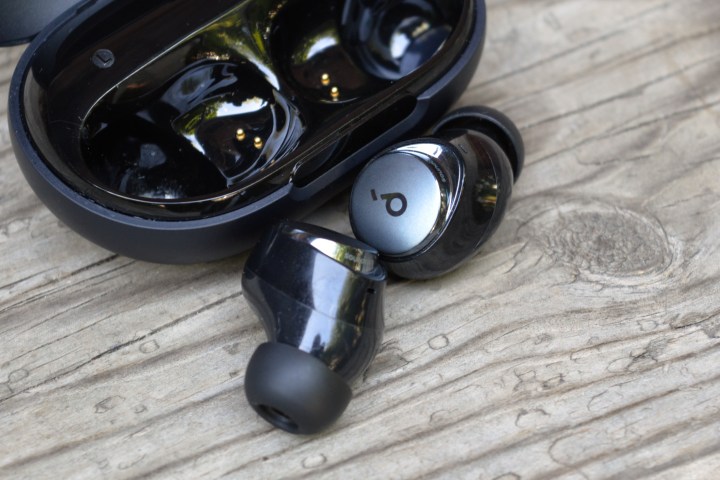
You’ll see plenty of $100 (or even cheaper) wireless earbuds on Amazon promising noise cancellation, but the reality is that most of them only offer mild versions of ANC — just enough to claim they do it, but nothing more. Soundcore makes the impressive claim that the Space A40 reduce noise by up to 98%, and while I’m not so sure I agree with that stat, the ANC on these earbuds is the real deal.
With ANC mode engaged, they’re very effective at blocking a wide spectrum of sound frequencies. My home office sits about eight feet from a loud and annoying bathroom fan, but the A40 almost entirely erase that sound. Based on that performance, I suspect they’ll be very good at handling airplane engine noise too.
With 10 hours of playing time (50 hours when you include the charging case), the Space A40 are downright impressive.
Transparency mode, which also tends to be mediocre on a lot of earbuds at this price, is surprisingly good. The outside world becomes perfectly audible, and voices are easy to hear. It’s not as magical as Apple’s AirPods Pro, but then again, not much is, at any price.
I really appreciate that the Soundcore app lets you decide which modes you want to access when you switch the ANC function. You can pick any two of ANC on, off, or transparency, or choose to cycle through all three. Far too many earbuds don’t let you do this.
Call quality
Calling on the Space A40 is decent. Loud sounds around you are fairly effectively blocked, but this can come at the cost of some compression and wonkiness in your voice. When things are quiet, you’ll sound just fine to your callers.
You can’t switch ANC mode while on a call using the touch controls, but you can do it using the app, which is helpful. Switching to transparency mode isn’t as clear as when you’re not on a call, but you can hear your own voice much better than in full ANC mode, which helps reduce calling fatigue.
Battery life
With a claimed 10 hours of playing time per charge for the earbuds and a total of 50 hours when you include the charging case (with ANC off), the Space A40 are downright impressive. Even when you start to add in additional features like ANC, they remain strong (8/40), and with maximum drain (the combination of LDAC and ANC), they still manage a 5/25, which, to put it in perspective, is what the AirPods Pro do at their best.
These numbers assume playback at 60% volume and from what I can tell, they’re pretty accurate — maybe off by plus or minus 30 minutes at most.
Regardless, these earbuds have remarkable stamina. Even their fast-charge time is noteworthy: 10 minutes in the charging case will buy you an extra four hours of playtime (non-ANC, non-LDAC).
With an astonishing number of features, most of which perform extremely well, and a price that is within reach of almost anyone who wants a set of wireless earbuds, the Soundcore Space A40 are truly a new benchmark in value. For the same money, you can get better sound, but only by sacrificing things like ANC, wireless charging, and battery life (Google Pixel Buds A-Series). You can get better water and dust protection (Skullcandy Grind Fuel), but you lose ANC and call quality.
Unless you have very specific tastes in sound (big bass, crystal clarity), or you need better protection from the elements, I highly recommend them.
Note: This review originally stated that Bluetooth multipoint is not a feature of the Space A40. This has been corrected.



